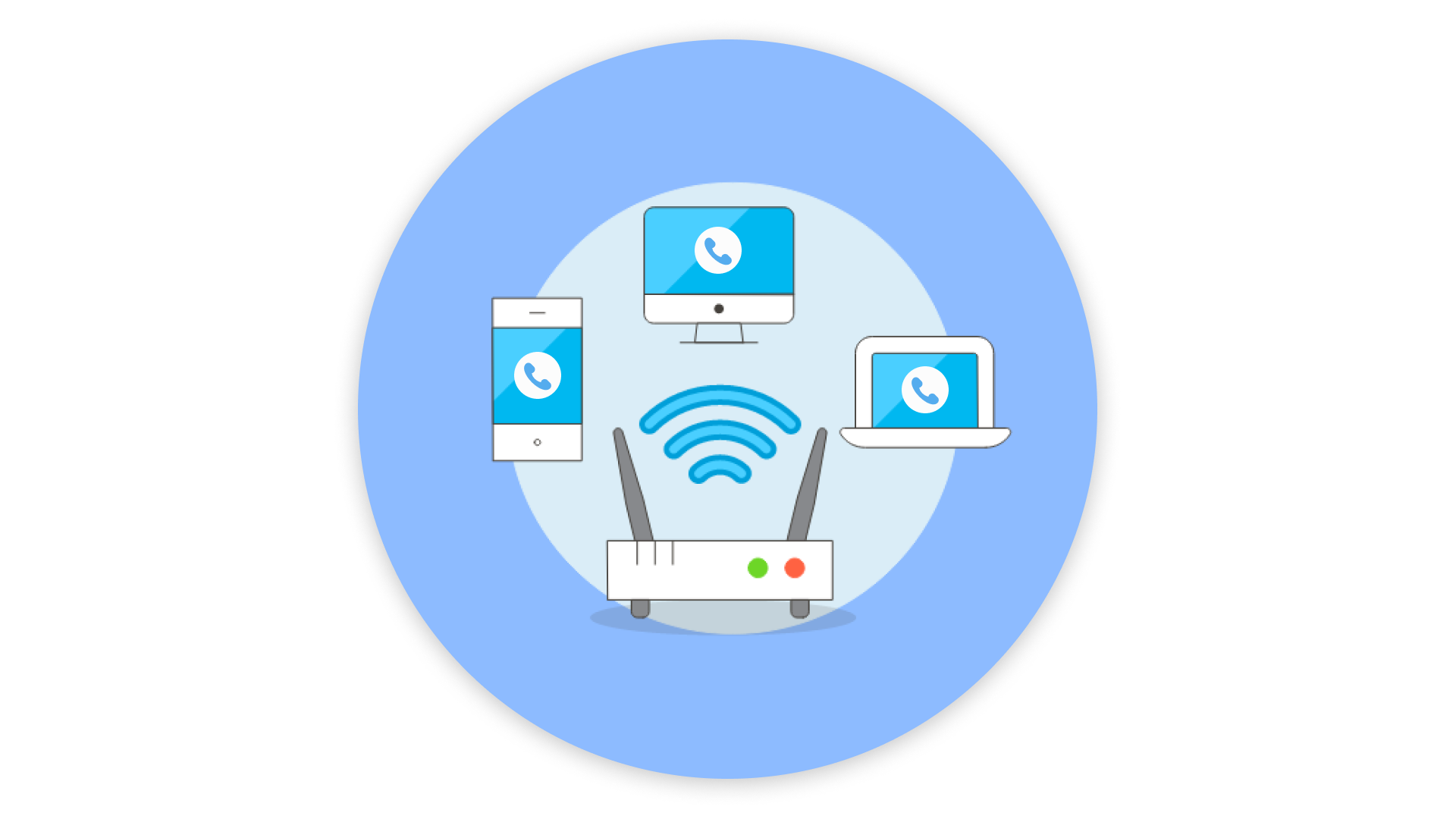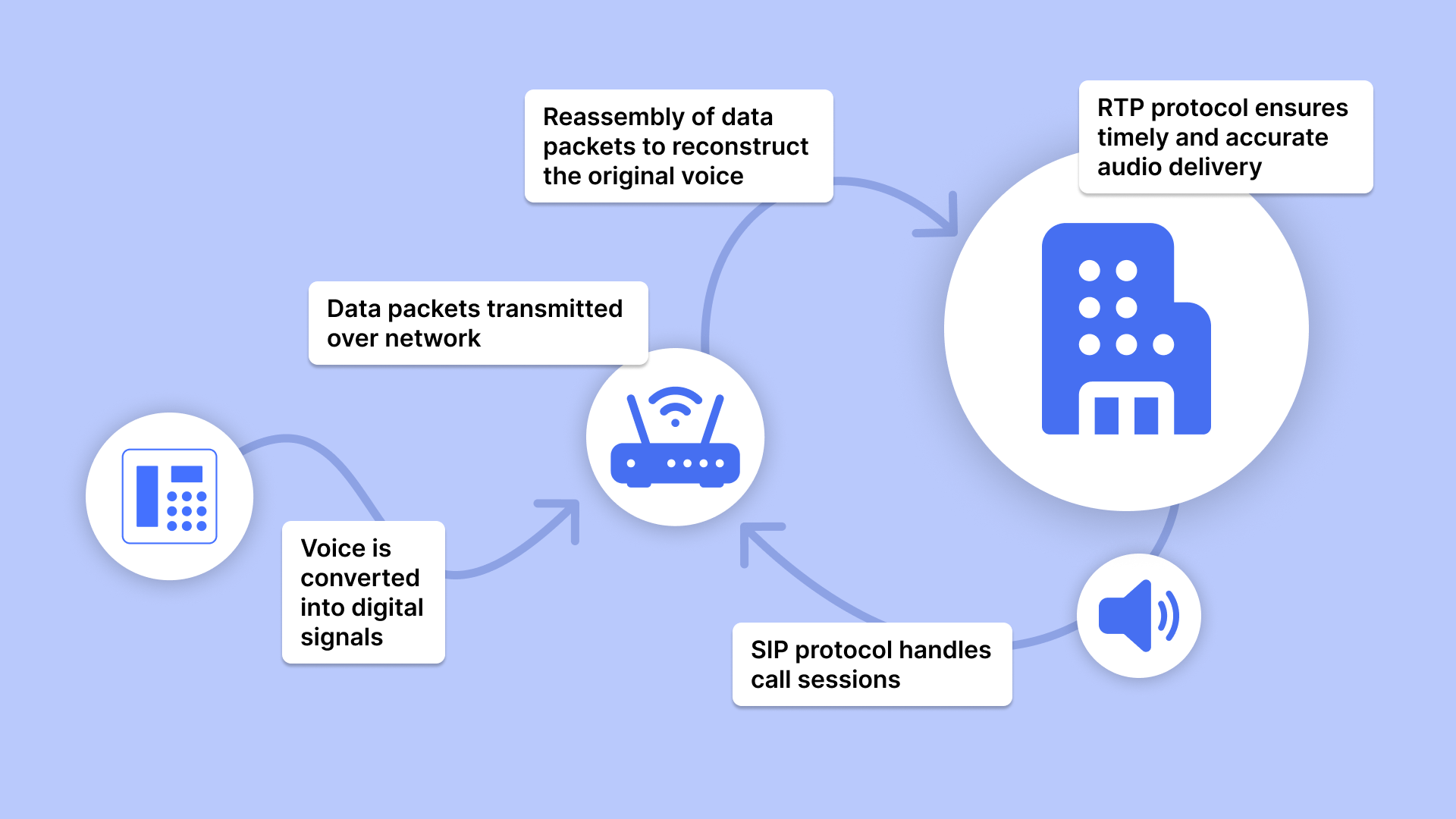Voice over Internet Protocol – VoIP: leveraging voice communication
Providing insights on VoIP telephony meaning and how it works.

As you may have noticed, over the past few years, VoIP (Voice over Internet Protocol) telephony has become an increasingly popular alternative to phone lines among businesses of various sizes. The technology makes it easy to establish cross-border communication for sales and support departments without incurring the sky-high costs of international calls. In the article, we will explore how VoIP telephony works and what advantages it offers to business.
Table of contents
VoIP telephony explained
Voice over Internet Protocol (VoIP) telephony is a technology for voice communication over the internet. It offers a cost-effective and high-quality alternative to traditional phones.
By converting analogue voice signals into digital data packets, VoIP enables users to make calls using their internet connection, eliminating the need for traditional phone landlines, which is particularly beneficial for individuals or companies making a lot of international calls.
How does VoIP work?
VoIP operates by transmitting voice data in packets over the internet. When a call is made, the analogue voice signal is digitized, compressed, and broken into data packets. These packets are then transmitted over the network to the recipient, where they are reassembled to deliver a seamless voice message. This process allows companies to establish clear and real-time voice communication across borders.

What protocols does VoIP use?
Voice over Internet Protocol (VoIP) relies on a range of protocols to enable seamless communication over the internet, with the two primary ones being SIP and RTP.
- Session Initiation Protocol (SIP) acts as the control protocol in VoIP systems, handling the initiation, modification, and termination of communication sessions between users. It establishes the necessary parameters for communication, such as setting up the call, negotiating codecs, and handling call features like call waiting or call forwarding.
- Real-time Transport Protocol (RTP) is crucial for VoIP as it handles the transmission of real-time audio and video data packets. It ensures that these packets are delivered promptly and efficiently, maintaining quality and synchronization during calls to provide a smooth and uninterrupted communication experience for users.
Together, SIP and RTP work in tandem, enabling efficient and high-quality voice communication over the internet, ensuring that VoIP calls are clear, reliable, and seamless for users.
What is the difference between VoIP and IP telephony?
While VoIP and IP telephony are often used interchangeably, there is a subtle distinction between the two. VoIP refers specifically to the transmission of voice data over IP networks, encompassing both hardware and software solutions. On the other hand, IP telephony is a broader term that includes all forms of telecommunication services, such as voice, video, and data transmission, over IP networks.
What is the difference between VoIP and cloud telephony?
Cloud telephony and VoIP share similarities in utilizing internet-based communication services, but they differ in deployment and scalability. VoIP typically involves on-premises equipment for call processing, whereas cloud telephony relies on hosted services in the cloud, offering flexibility and scalability for businesses. Cloud telephony also provides additional features like auto-replies, call recording, and analytics, enhancing overall communication efficiency.
Advantages of VoIP telephony
Incorporating Voice over Internet Protocol (VoIP) in a company's communication infrastructure offers multiple advantages.

Better audio quality
VoIP telephony ensures clear audio quality during calls, enhancing the overall communication experience. While landline phones rely on analogue methods of sound decoding, VoIP is digital, which results in clearer and crisper sound. The only requirement here is a fast and stable internet connection with bandwidth sufficient for high-quality voice transmission.
Higher productivity and flexibility
As VoIP enables seamless connectivity to corporate phone systems, it offers features like auto-replies and video calling that traditional phones lack. This facilitates increased employee productivity, reduces utility costs, and optimizes office space usage.
Moreover, since VoIP is easily accessible, it allows people to connect, regardless of their locations, through a smartphone app, enhancing business flexibility and enabling employees to work remotely. The portability of VoIP numbers makes it easy to maintain a consistent number even when changing locations, making telephony an ideal solution for frequent travelers and businesses looking to adapt to changing circumstances.
More scalability
VoIP can be an ideal communication tool for growing organizations. With the flexibility to host large-scale conference calls and add or remove users as needed, VoIP can adapt to the evolving needs of expanding businesses as they emerge in new markets and regions.

Increased cost savings
Studies reveal that organizations can save up to 50% on their phone bills by adopting Voice over Internet Protocol technology systems, making it a financially attractive option for businesses seeking to streamline communication expenses.
VoIP eliminates the need for on-site PBX hardware, known for its high installation costs, by leveraging broadband connections and Session Initiated Protocol (SIP) trunking for seamless upgrades. This cost-effective approach not only reduces direct expenses but also eliminates the need for extra wiring charges, allowing organizations to optimize their resources effectively.
Disadvantages of VoIP
Despite numerous benefits, the technology of VoIP telephony does come with some drawbacks. Latency issues, caused by poor internet connections or inadequate hardware, can affect call quality. To mitigate latency problems, utilizing high-speed internet, upgrading Ethernet cables, and implementing the appropriate VoIP router are essential steps to ensure smooth VoIP operations.
Additionally, reliance on internet access for VoIP services requires strong security measures to safeguard VoIP communication from potential threats like phishing and service denial attacks.
How to set up VoIP
The exact process of setting up Voice over Internet Protocol depends highly on the organization's structure, the number of employees, and business goals. However, there are some essential steps common for the majority of cases:
- Choose a VoIP provider that aligns with your business needs. Consider factors like pricing, features, scalability, and customer support.
- Assess the company's network infrastructure. Ensure your internet connection meets the bandwidth requirements for VoIP. Evaluate your network setup to prioritize voice traffic for optimal call quality.
- Select VoIP equipment. Decide on the type of VoIP phones needed for your setup and check if additional hardware like headsets or conference devices is required.
- Configure VoIP by setting up user accounts, and customizing call routing preferences and other features: voice mail, call forwarding, and auto-attendant.
- Test how the system works and provide training to employees on efficient VoIP system usage.
Implementing VoIP can enhance communication efficiency and reduce costs for your business. By following these steps, you can establish a robust VoIP system tailored to your organization's requirements.
How much does VoIP cost?
There are multiple considerations that companies should take into account while budgeting for VoIP integration. The one-time costs are mostly built from hardware purchases of IP phones, routers, and adapters as well as the possible charges for other devices like headsets or conference equipment.
Regularly incurring costs include subscription plans that can vary by supported features, use caps, and number of users catered. Companies should also consider the setup and installation fees that certain providers charge, as well as possible implementation of optional features like virtual fax services, call recording, and CRM integrations.
Summing things up
VoIP telephony has emerged as an optimal solution for businesses seeking alternatives to traditional phone systems. As explored in the article, the technology empowers businesses of all sizes to establish seamless cross-border communication channels and streamline sales and support operations without the burden of exorbitant international call charges.
If you are looking for a cost-effective VoIP telephony solution, consider using Umnico Inbox omnichannel messaging platform, which allows you to combine your voice- and text-based communication in a single interface. By leveraging the platform’s advanced features, users can optimize customer interactions across VoIP telephony and social platforms, such as WhatsApp, Instagram, Facebook Messenger, and others. Umnico Inbox also allows managers to monitor employees' performance, and automate tasks, fostering an effective omnichannel customer communication. No financial commitment is required – every new user can try Umnico for free during a trial period.

Subscribe to Umnico news!
Be the first to get recommendations and up-to-date information
